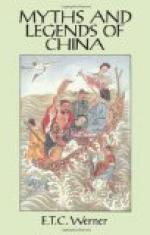As regards geological features, the great alluvial plains rest upon granite, new red sandstone, or limestone. In the north is found the peculiar loess formation, having its origin probably in the accumulated dust of ages blown from the Mongolian plateau. The passage from north to south is generally from the older to the newer rocks; from east to west a similar series is found, with some volcanic features in the west and south. Coal and iron are the chief minerals, gold, silver, copper, lead, tin, jade, etc., being also mined.
The climate of this vast area is not uniform. In the north the winter is long and rigorous, the summer hot and dry, with a short rainy season in July and August; in the south the summer is long, hot, and moist, the winter short. The mean temperature is 50.3 deg. F. and 70 deg. F. in the north and south respectively. Generally, the thermometer is low for the latitude, though perhaps it is more correct to say that the Gulf Stream raises the temperature of the west coast of Europe above the average. The mean rainfall in the north is 16, in the south 70 inches, with variations in other parts. Typhoons blow in the south between July and October.
Organic Environment
The vegetal productions are abundant and most varied. The rice-zone (significant in relation to the cultural distinctions above noted) embraces the southern half of the country. Tea, first cultivated for its infusion in A.D. 350, is grown in the southern and central provinces between the twenty-third and thirty-fifth degrees of latitude, though it is also found as far north as Shantung, the chief ‘tea district,’ however, being the large area south of the Yangtzu River, east of the Tungting Lake and great Siang River, and north of the Kuangtung Province. The other chief vegetal products are wheat, barley, maize, millet, the bean, yam, sweet and common potato, tomato, eggplant, ginseng, cabbage, bamboo, indigo, pepper, tobacco, camphor, tallow, ground-nut, poppy, water-melon, sugar, cotton, hemp, and silk. Among the fruits grown are the date, mulberry, orange, lemon, pumelo, persimmon, lichi, pomegranate, pineapple, fig, coconut, mango, and banana, besides the usual kinds common in Western countries.
The wild animals include the tiger, panther, leopard, bear, sable, otter, monkey, wolf, fox, twenty-seven or more species of ruminants, and numerous species of rodents. The rhinoceros, elephant, and tapir still exist in Yuennan. The domestic animals include the camel and the water-buffalo. There are about 700 species of birds, and innumerable species of fishes and insects.
Sociological Environment
On their arrival in what is now known as China the Chinese, as already noted, fought with the aboriginal tribes. The latter were exterminated, absorbed, or driven south with the spread of Chinese rule. The Chinese “picked out the eyes of the land,” and consequently the non-Chinese tribes now live in the unhealthy forests or marshes of the south, or in mountain regions difficult of access, some even in trees (a voluntary, not compulsory promotion), though several, such as the Dog Jung in Fukien, retain settlements like islands among the ruling race.




